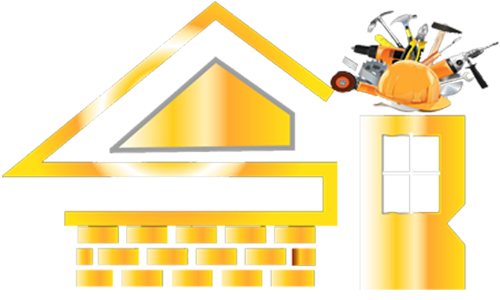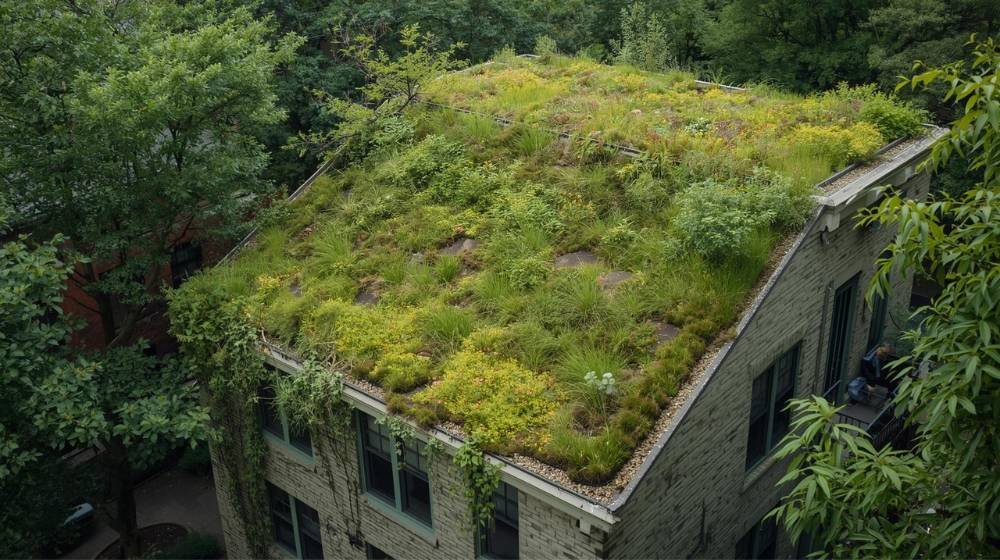
Have you noticed gardens on rooftops across Brooklyn?
You see them in schools, co-ops, warehouses, and brownstones. These are green roofs. They have cool rooms. They cut energy use. They shield the roof from the sun and big temperature swings. They slow the rain and help old sewers. They add habitat and a calm spot above the street. Many owners ask if a green roof is a good fit for their building, budget, and NYC regulations. This guide gives clear answers.
In simple terms, a green roof is a roof with plants and engineered layers above a waterproof membrane. The layers manage water, air, and roots. The result is comfort, protection, and real value for city buildings.
In this blog post, we will break down everything you need to know about green roofs for Brooklyn, NYC. We will explain how a green roof works. We will compare types and plant choices. We will show design options used in the city and explain the design volume with plain calculations. Let’s explore it.
What Is a Green Roof?
A green roof is a roof with plants and engineered layers above a waterproof base. It cools the building and protects the membrane from the sun and heat. It slows stormwater and eases pressure on city drains. It also adds beauty and habitat in dense areas.
Types of Green Roofs
Green roofs come in a few core types. The type depends on factors such as soil depth, plant choice, weight, and intended use. Select a type that aligns with your structure and goals.
Extensive Green Roof
- Description: A light, thin system with hardy, low plants.
- Features:
- Shallow media depth
- Low weight per square foot
- Simple irrigation needs
- Limited access for people
- Advantages:
- Lower cost than deeper systems
- Less maintenance
- Good thermal performance
- Faster install
- Materials: Root barrier, drainage layer, filter fabric, 3–6 in. media, sedum.
- Ideal for: Flat or low-slope roofs with tight budgets and limited structural capacity.
Semi-Intensive Green Roof
- Description: A mid-depth system with mixed plants and seasonal color.
- Features:
- Medium media depth
- Mix of sedum, grasses, and herbs
- Optional drip irrigation
- Some access to care
- Advantages:
- More biodiversity
- Better stormwater storage
- More design options
- Moderate maintenance
- Materials: Root barrier, drainage board, filter fabric, 6–10 in. media, mixed planting.
- Ideal for: Buildings that can support a heavier load and require richer planting.
Intensive Green Roof
- Description: A deep system that acts like a rooftop garden or park.
- Features:
- Deep media depth
- Can support shrubs and small trees
- Regular irrigation
- Designed walkways and seating
- Advantages:
- Usable outdoor space
- Highest amenity value
- Strong habitat potential
- Best microclimate control
- Materials: Root barrier, high-capacity drainage, filter fabric, 10 inches or more of media, and diverse plants.
- Ideal for: Strong structures, premium amenity decks, and public or mixed-use buildings.
Biodiverse (Brown) Roof
- Description: A habitat-focused roof that uses varied media and found materials.
- Features:
- Uneven depths and micro-habitats
- Logs, stones, and sand pockets
- Native seed mixes
- Low foot traffic
- Advantages:
- High ecological value
- Supports pollinators and birds
- Resilient plant communities
- Low irrigation demand after establishment
- Materials: Root barrier, drainage, filter fabric, mixed media depths, habitat elements, native seeds.
- Ideal for Sites with ecological goals and limited public access needs.
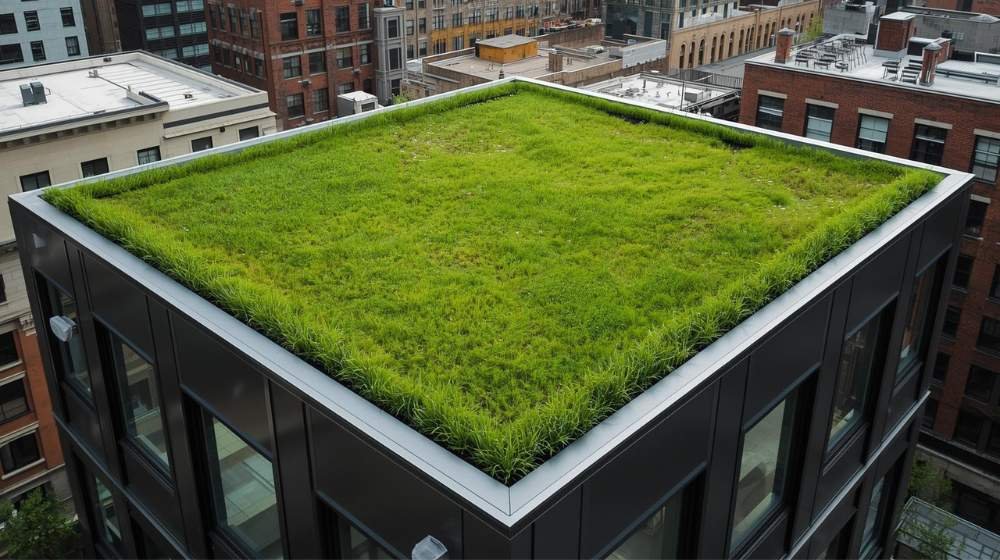
Master Plant Table: Green Roof Plants & Vegetation (Brooklyn, NY)
| Plant (Common) | Latin name | Min depth (in) | Sun | Height (in) | Best-use tags* | Notes for Brooklyn (Zone 7b) |
| Basil | Ocimum basilicum | 6–8 | Full | 12–24 | Medium, Edible | Heat lover. Pinch to keep bushy. Protect from cold snaps. |
| Parsley | Petroselinum crispum | 6–8 | Full–Part | 10–18 | Medium, Edible | Cool tolerant. Suits spring and fall. Keep soil evenly moist. |
| Rosemary | Salvia rosmarinus | 8–10 | Full | 12–24 | Medium, Edible, Evergreen (semi) | Needs sharp drainage. Can overwinter in mild winters. Shelter from harsh wind. |
| Oregano | Origanum vulgare | 6–8 | Full | 8–18 | Medium, Edible | Spreads by root. Use pots or a barrier. Dry site is best. |
| Mint | Mentha × piperita | 6–8 | Part–Full | 12–24 | Medium, Edible | Very vigorous. Grow in pots. Likes steady moisture. |
| Lettuce | Lactuca sativa | 8–10 | Part–Full | 6–12 | Medium, Edible | Cool season crop. Spring and fall harvests. Shade cloth helps in heat. |
| Kale | Brassica oleracea var. sabellica | 10–12 | Full | 18–36 | Deep, Edible | Handles frost. Choose compact types. Watch for cabbage worms. |
| Swiss chard | Beta vulgaris subsp. cicla | 8–10 | Full | 12–24 | Medium, Edible | Heat and cold tolerant. Cut outer leaves. Needs regular water. |
| Cherry tomato | Solanum lycopersicum var. cerasiforme | 12–16 | Full | 24–60 | Deep, Edible | Needs cage or trellis. Feed and water on a schedule. Warm site yields best. |
| Bell pepper | Capsicum annuum | 10–12 | Full | 18–30 | Deep, Edible | Likes heat. Black mulch adds warmth. Harvest often to boost set. |
What Are the Different Designs of Green Roofs in Brooklyn?
Brooklyn is situated in a coastal zone with hot summers and frequent, intense storms. Roofs see wind and freeze-thaw cycles. Good design respects structure, drainage, and local code. These five options work well across the borough.
- Sedum Carpet Roof: This design uses pre-grown mats for full cover in a short time. Weight stays low, so older buildings can handle it. Crews can install large areas with simple gear. Stormwater control is solid for brief storms. Color shifts with seasons and adds a clean, modern look.
- Mixed Meadow Roof: This design blends sedum with grasses and wildflowers. The mix brings long bloom waves and strong habitat value. Water storage increases with the addition of extra roots and media. Mow once or twice per year and remove weeds on a set schedule. The roof reads like a small prairie above the street.
- Blue-Green Detention Roof: This design stores water under the media in a shallow void. Flow leaves the roof at a set rate through controls. The system reduces street ponding on flood-prone blocks. City agencies like this approach because it protects sewers. You still get plants on top, so the roof stays cool and alive.
- Urban Farm Roof: This design sets deep beds for herbs and produce. It needs irrigation, tools, and a clear access plan. Community groups and schools utilize it for food and educational purposes. The farm can host events and small markets. The structure must be able to carry higher loads with a safety margin.
- Modular Tray Roof: This design uses trays that lock edge to edge. Crews lift, place, and replace units with little mess. The format suits tight stairwells and narrow hatches. Owners can phase the project by zone and budget. The dry weight remains predictable because each tray has a set depth.
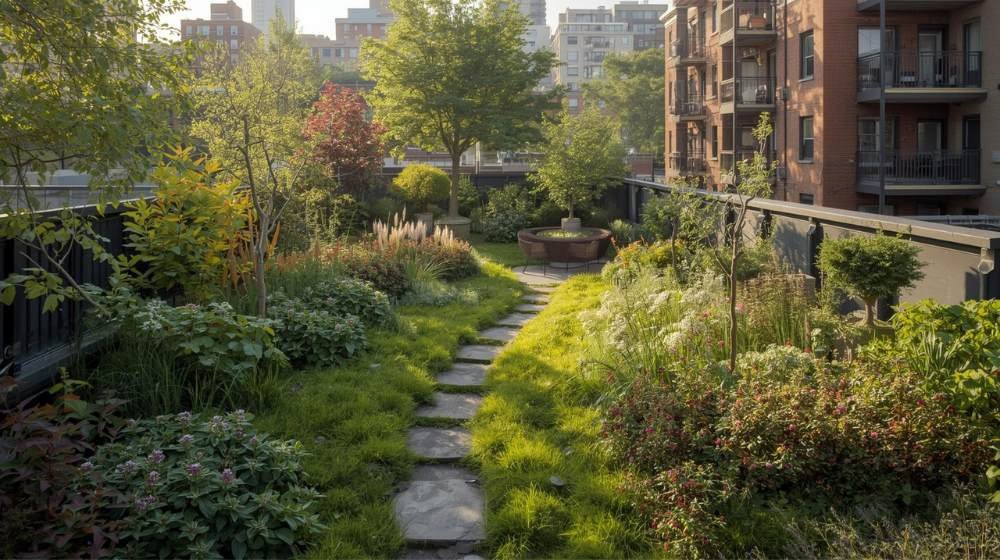
Design Volume
DV measures the amount of water the roof can hold during a storm. In cities like Brooklyn, NYC, where drainage systems face pressure from heavy rain, knowing DV helps property owners and designers create roofs that are both sustainable and practical. With a simple formula, anyone can estimate the storage capacity of a green roof based on soil depth, plant water needs, and roof size.
Formula:
DV=12PAW×dmedia×Agr/12
For this table, I’ll assume:
- PAW = 0.20 in/in (typical value)
- Media depths = 4″, 6″, 8″, 10″, 12″
- Roof areas = 500, 1,000, 2,000 sq ft
| Media Depth (in) | 500 sq ft | 1,000 sq ft | 2,000 sq ft |
| 4 in | 33 cu ft | 67 cu ft | 133 cu ft |
| 6 in | 50 cu ft | 100 cu ft | 200 cu ft |
| 8 in | 67 cu ft | 133 cu ft | 267 cu ft |
| 10 in | 83 cu ft | 167 cu ft | 333 cu ft |
| 12 in | 100 cu ft | 200 cu ft | 400 cu ft |
Pros and Cons of Green Roofing
Green roofing brings real gains for city buildings. It cuts heat on the roof and cools nearby air. It also holds stormwater and can protect the roof membrane. The trade-offs include extra weight, a higher upfront cost, and ongoing care needs.
Advantages of Green Roofing
- Strong stormwater control: A green roof can hold a large share of a rain event before water reaches drains. Many studies report an average retention rate of roughly 50–80% over time. It depends on the climate and the depth of the water. This eases street flooding and supports NYC sewer goals.
- Lower heat flow and cooler roofs: Research shows that summer heat flow through the roof can drop by up to 80% with the addition of vegetation and media layers. Roof surfaces also run cooler, which helps indoor comfort. That effect cuts peak heat on hot Brooklyn days.
- Longer membrane life: Plants and media shade the waterproofing from UV and large temperature swings. That protection can double the roof’s life compared with a bare roof. Fewer re-roof cycles mean less waste and lower long-term cost.
- Urban heat island relief: Vegetation adds shade and cools the air through evapotranspiration. This lowers roof and near-roof temperatures. City blocks feel the benefit on hot days.
- More habitat and biodiversity: Green roofs support pollinators and small wildlife. They add stepping-stone habitats across dense neighborhoods. Brooklyn sites gain color and seasonal interest.
- Noise reduction: Media and plants absorb and deflect sound. Studies show meaningful drops in noise levels compared with hard roofs. Indoor and courtyard spaces feel calmer.
- Amenity and property value potential: Usable roofs add social space and visual appeal. Some studies have noted value gains and operating savings, although results vary by project. Owners often cite the broader benefits to their well-being.
Disadvantages of Green Roofing
- Higher upfront cost: Green roofs need special layers, plants, and trained labor. Costs can exceed conventional roofs. Payback depends on energy savings, roof life, and incentives.
- Added weight on the structure: Wet media is heavy and adds live load. A structural check is mandatory before design. Engineers set depth limits and safety factors.
- Waterproofing and leak risk increase when detailing is weak: Most failures are traced to seams, drains, or flashings. A root-resistant membrane and protection layers cut risk. Testing and inspection catch small issues early.
- Maintenance and access needs: Even thin roofs need weeding, drain checks, and seasonal care. Safe paths and anchors keep crews efficient. Skipping visits can lead to more significant issues later.
- Plant loss due to drought or wind: Shallow roofs dry out quickly in summer. Edge zones see wind stress and salt. Tough plant lists and backup irrigation improve survival.
Environmental Benefits of Green Roofs
Green roofs help cool the surface and the air just above the building. EPA reports show that roof surface temperatures can drop by up to 56°F compared to dark roofs. Cooling loads inside can fall up to 70%, which means less heat enters the building. Roofs also retain rain and release it slowly, so streets see less runoff during storms. These effects contribute to cleaner air, improved comfort, and reduced peak energy demand.
Common Problems and Solutions of Green Roofs
Green roofs work well when design and care stay simple. Still, problems can show up. Below, we outline the problem, followed by a clear solution you can implement right away.
- Problem: Clogged drains and outlets
Debris, wind-blown seeds, and loose media can block inlets. Water ponds and adds weight. Leaks can follow.
Solution: Add inspection ports and leaf guards. Check drains after big storms and at least twice per year. Keep vegetation and fabric clear of outlets. Take quick photos for records. - Problem: Membrane punctures and weak seams
Tools, foot traffic, and later trades can nick the waterproofing. Roots can find gaps at seams. Small cuts turn into leaks.
Solution: Use a root-resistant membrane with a separate root barrier and protection sheet. Water-test the seams before planting, then re-test after other trades have finished. Keep a repair kit on site. - Problem: Drought stress and plant die-off
Shallow media dries fast in July heat. Edges get windburn. New roofs suffer the most.
Solution: Choose drought-hardy plants for thin areas. Irrigate during establishment and set a simple dry-spell rule. Add drip lines where summer heat hits hardest. - Problem: Overwatering and waterlogging
Poor drainage traps water in the media. Roots suffocate. Algae and odors can appear.
Solution: Confirm drainage board flow and outlet heights in design. Use engineered media with high porosity and low organic content. Add moisture checks and adjust irrigation according to the season. - Problem: Weeds and tree seedlings
Seeds land on bare spots and grow fast. Roots thicken and can clog edges. A few months of neglect make removal hard.
Solution: Perform routine walks and gently pull seedlings while they are small. Aim for dense cover to shade the soil and protect it from erosion. Keep a short weed list for crews. - Problem: Wind uplift and media erosion at edges
Strong gusts scour corners and parapets. Trays shift on exposed roofs. Light media can move.
Solution: Add erosion grids or edge ballast. Follow wind-uplift standards for vegetative roofs and set ballast by zone. Use tougher plants and heavier stone in perimeter strips. - Problem: Access and safety gaps
No safe path means skipped visits. Missed checks hide small issues. Compliance can slip.
Solution: Plan a clear route, tie-off points, and simple checklists. Log each inspection. NYC also requires a professional inspection for incentive compliance.
What Is a Green Roof System?
A green roof system is a set of layers that allows plants to live on a roof. It protects the waterproofing, holds water for plants, and drains the rest. It also keeps weight within what your structure can carry. Below are the primary system styles you will see on real projects.
- Tray systems: These use pre-grown modules that click together on the roof. Crews lift trays by hand and place them fast, so access is simple and the mess stays low. You can swap a single tray to fix damage or reach the deck. Brands show sizes around 500×500 mm and design features for water storage and fire rating.
- Layered Sponging Element systems (SE): These utilize a water-holding fleece or mat that is placed under the soil. The fleece acts like a sponge and gives slow release to roots. Some versions guide extra water across ribbed channels, so runoff stays under control on slopes. Tech sheets list water storage in liters per square meter for planning.
- Granular Drainage, layered (GD): These rely on loose, porous minerals such as expanded clay or lava rock. The grains create air space and fast drainage under the soil. They are light for their volume, so the load stays lower than with gravel. Maker’s note: better aeration and stable temperatures around roots.
- Drainage Board, layered (DB): These use molded plastic boards with cups that store water and channels that drain the rest. The board sits under a filter fabric and the soil. The specifications list storage per square meter and load capacity, ensuring the design remains predictable. Many products are made from recycled polymers and are suitable for extensive or intensive roofs.
- Monolithic Platform systems: These arrive as large panels that combine protection, storage, and flow control. They form a continuous platform under the soil, so the roof acts like one unit. This format pairs well with blue-roof detention and solar gear. Industry sources describe it as flexible for many depths and uses.
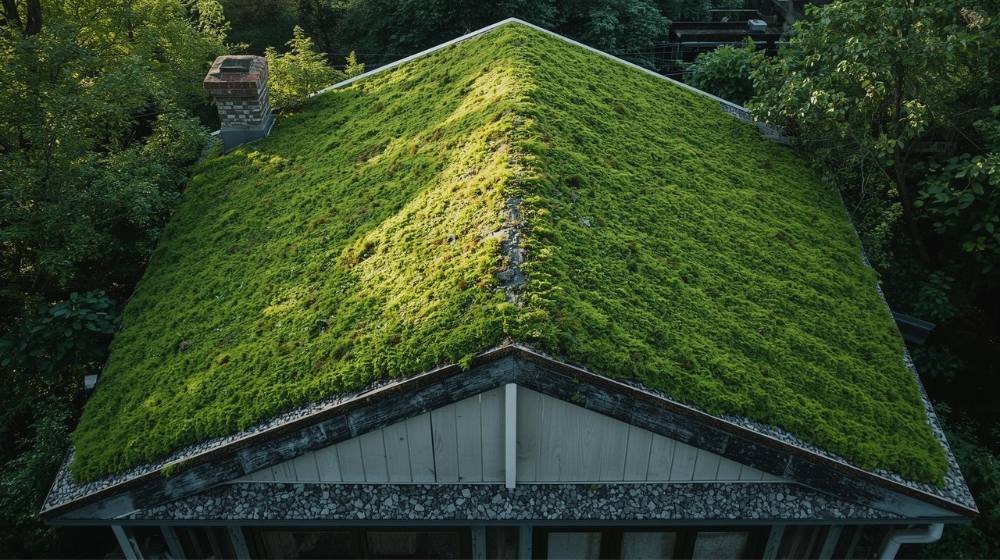
How to Install a Green Roof
A good green roof starts with a safe structure and a dry roof. The build is a clean stack of layers that hold water for plants and move extra water to drains. Follow these steps and keep each one simple.
1) Do a structural and code check: Hire a licensed engineer to confirm the roof can carry wet weight with a safety margin. Note access, parapet height, anchors, and fire breaks. Confirm local rules for coverage, edges, paths, and inspections.
2) Test and prepare the waterproofing: Fix weak seams and flashings before any green roof work. Flood-test or use electronic leak detection to confirm a tight membrane. Add a smooth protection board to prevent tools from nicking the surface.
3) Place the root barrier and protection sheet: Use a membrane that blocks roots and matches the roof system. Seal the laps according to the maker’s details and keep the sheet smooth. Turn it up at edges and penetrations so roots do not find gaps.
4) Install drainage and set outlet controls: Lay drainage boards or granular drainage to create an air space and storage. Maintain outlet heights according to the design to ensure water leaves at a steady rate. Leave inspection ports at each drain for fast checks.
5) Add filter fabric across the full area :Run fabric over the drainage layer so the media does not wash into the cups or voids. Overlap seams according to specifications to prevent fines from shifting. Trim cleanly around inspection ports and edges.
6) Place growing media to the target depth: Use engineered media with high porosity and low organics. Rake to an even depth and add extra material at the edges where the wind hits hardest. Lightly wet the media so dust stays down and roots start well.
7) Plant, irrigate, and finish edges: Set sedum mats, plugs, or a seed mix that fits the sun and depth. Add temporary or drip irrigation to help plants establish a strong root system quickly in their first season. Install metal edging, firebreaks, and walking pads for care paths.
How much does a green roof installation cost (per sq. ft.) in Brooklyn, NYC?
Costs in Brooklyn vary depending on the depth, access, and scope. The table below shows typical 2025 ranges per square foot for the green roof layers and planting. These figures exclude the cost of a new base roof, railings, permits, cranes, and long-term care.
| Green roof type | Material Cost (per sq. ft.) | Labor Cost (per sq. ft.) | Total Cost (per sq. ft.) |
| Extensive (thin, sedum) | $18 – $28 | $18 – $32 | $36 – $60 |
| Semi-Intensive (mid-depth mix) | $25 – $45 | $25 – $40 | $50 – $85 |
| Intensive (deep, amenity) | $45 – $95 | $40 – $90 | $85 – $185 |
Notes for owners
These comprehensive green roof ranges have a solid, assured membrane. Subject to requirements and caps, an NYC property tax exemption may reduce the net cost by $10 or $15 per square foot in eligible districts. For a fair scope comparison, ask contractors to separate access gear, irrigation, blue-roof controls, and maintenance.
Application of Green Roof in Brooklyn, NYC
Brooklyn has hot summers, fast storms, and many flat roofs. A green roof helps with heat, water, and space. Here are good ways to use it across the borough.
- Schools and community centers: Create outdoor learning beds for herbs and pollinators. Use safe paths and railings to ensure classes move smoothly. Add signs so students connect the roof to stormwater and heat relief.
- Co-ops and condos: Provide residents with a calm space above the street. Set furniture on pavers and keep planters clear of drains. Post a simple care plan so the board knows who is responsible for what.
- Warehouses and light industry: Lower summer heat over large flat roofs. Add blue-green controls so flow leaves the site at a set rate. Keep access simple so crews can reach drains fast after big storms.
- Brownstones and rowhouses: Utilize light, shallow systems that are compatible with older structures. Focus depth toward the center and use wind-tough plants at edges. Keep trays small so they pass through narrow hatches.
- Public buildings and libraries: Cut roof temperature and improve comfort inside. Pair habitat zones with seating near parapets. Use photo logs to show staff the results over time.
- Mixed-use decks over retail: Design deeper beds for shade and small trees. Plan irrigation and hose bibs so care stays easy. Separate care paths from seating so visitors do not step into plant areas.
- Solar + green roof (biosolar): Place panels on racks above low plants to boost PV output with cooler air. Keep clear zones for maintenance and fire access. Use sedum or low-growing meadows to keep the shade under panels healthy.
What color to paint a house with a green roof?
A green roof pairs well with neutrals like white, cream, warm beige, greige, and soft gray.
Earth tones, such as sand, tan, taupe, terracotta, and brick red, add warmth and evoke the natural beauty of stone.
Cool tones like slate, navy, dusty blue, and misty sage create a calm, coastal look.
Deep contrast with charcoal or near-black adds drama, while soft pastels on trim or doors add lift without fighting the roof.
Future Trends in Green Roof Technology
Expect wider use of biosolar roofs that blend low-vegetation areas with PV racks to keep panels cooler and boost output, while saving space on tight city roofs. Blue-green systems that store water under the media and release it at a set rate will spread in cities with stricter stormwater rules and heavier cloudbursts.
Smart irrigation systems with soil-moisture sensors and simple controllers can reduce water use and help plants withstand heat waves. Lightweight, modular trays; recycled materials; native seed mixes; and easy-to-access inspection ports will speed up installations and help crews care for roofs safely.
Expert Tips for the Care and Maintenance of Green Roofing
Care stays simple when you follow a short list and keep photo logs. Set a calendar, assign a responsible person, and walk the roof on a routine.
- Check drains after big storms and every spring and fall.
- Inspect seams, flashings, and edges before each growing season to ensure they are in good condition.
- Water new plants on a schedule for the first summer, then follow a dry-spell rule.
- Pull weeds and tree seedlings while their roots are still small.
- Add extra media at corners and parapets where wind hits hardest.
- Test irrigation lines, timers, and backflow devices at the start of summer.
- Keep a one-page log with dates, photos, and brief notes on small fixes.
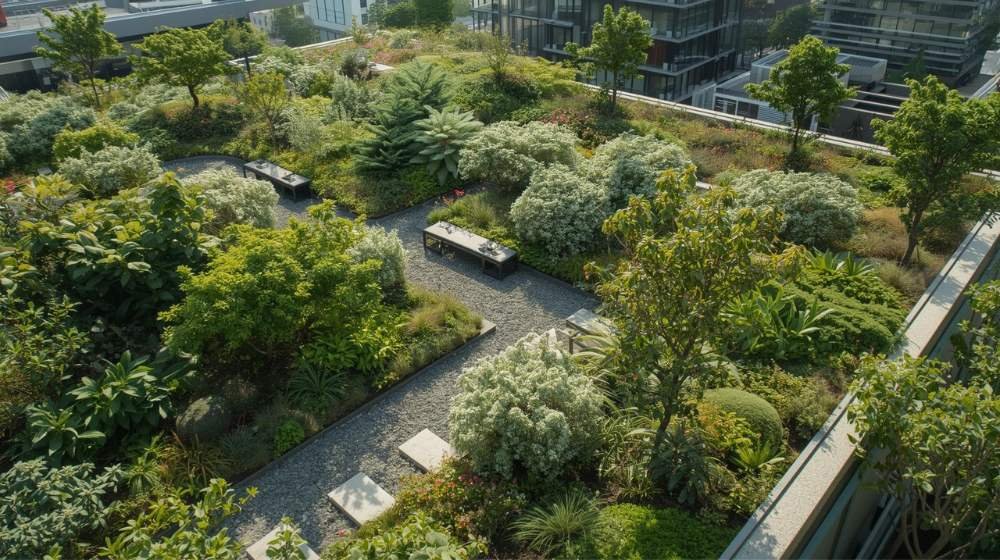
Why should you choose a professional roofing contractor?
Are you looking for an expert roofing contractor in Brooklyn, NYC? SR General Construction has you covered! Our business is located at 8807 Avenue B, Brooklyn, NY 11236, United States, in the Canarsie area.
We proudly serve all areas of Brooklyn with high-quality, durable roofing solutions. From new installations to repairs and maintenance, we provide the best service at affordable prices. Contact us and experience why we’re Brooklyn’s roofing experts!
FAQ
1. What is a green roof?
A green roof is a roof with engineered layers and plants above a waterproof membrane. The layers hold some rain, protect the roof, and keep rooms cooler.
2. How much does a green roof cost per square foot in Brooklyn, NYC?
Typical turnkey ranges are approximately $36–$60/sq ft for extensive systems, $50–$85/sq ft for semi-intensive systems, and $85–$185/sq ft for intensive systems. These figures exclude the cost of a new base roof, permits, railings, cranes, and long-term care.
3. How much weight does a green roof add?
A shallow extensive system often adds roughly 15–35 psf when saturated. Deeper intensive systems can reach 50–150+ psf, so an engineer must confirm capacity.
4. Is there an NYC green roof tax abatement?
Yes. As of 2025, the abatement is $10 per square foot citywide and $15 per square foot in select districts, subject to caps and program rules.
5. How long does a green roof last?
A well-built green roof can protect the membrane for 40 years or more. Plants and media shield the waterproofing from UV and heat swings.
6. Which plants work best in Brooklyn (Zone 7b)?
For shallow areas, use sedum mixes and tough groundcovers. For deeper beds, use herbs and compact edibles like basil, rosemary, kale, chard, peppers, and cherry tomatoes.
7. Can I combine solar panels with a green roof (biosolar)?
Yes. Low-lying plants under raised panels can cool the array and maintain steady output, while clear paths protect access and serve as firebreaks.
8. What is Design Volume (DV), and how do I estimate it?
DV is the storage capacity during a storm. A quick estimate uses the formula DV (cu ft) = PAW × media depth (in) × roof area (sq ft) ÷ 12, with PAW commonly taken as 0.20 in/in for planning purposes.
